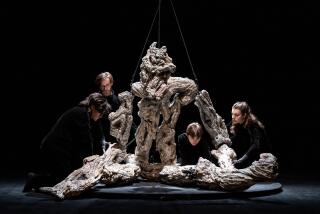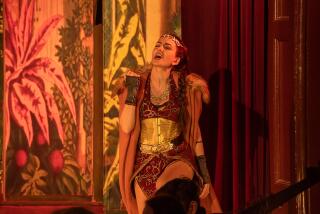MUSIC REVIEW : Italy’s Ars Ludi Offers Challenging Native Fare
- Share via
Although its repertory of new music comes from composers the world over, the Italian new music group Ars Ludi doesn’t demur from providing an ambassadorial function. Its concert at the Los Angeles County Museum of Art on Monday consisted entirely of music by Italian composers, from the better-known--Luciano Berio and Giacinto Scelsi--to the lesser-known.
Cultural presumptions from such a program aside, the music on this Monday Evening Concert was challenging and satisfying, and broad in its range--especially considering the limited parameters of the group. By nature, this is a percussive quartet, comprising percussionists Gianluca Ruggeri and Antonio Caggiano and keyboardists Oscar Pizzo and Suyum Kim, with occasional electronic interjections.
The unusual fabric of the group was neatly introduced with Maurizio Pisati’s “7,” highlighting seven percussion segments of varying rhythmic intensity and sonic density--from legitimate concert drums to the sound of a steel ball rolled on a plywood slab--interspersed with spare keyboard sections and fool-the-ear digital samples.
Also from the lesser-known contingent came Claudio Ambrosini’s “Ballo Sghembo,” full of deliberate, John Adams-esque chordal shifts. Giorgio Battistelli’s “Anima,” a solo piece performed on bass drum and marimba, projected a different brand of post-minimalism, full of both fluttery vibrancy and funereal poise.
Long dismissed by a myopic new musical Establishment, Scelsi’s music has enjoyed a late-blooming revival. In his 1955 solo piano piece “Action Music,” played sensitively by Pizzo, chromatic lines run in loops around a note that struggles vainly to become a key center. Later come clobbering clusters and a skewed delicacy reminiscent of Erik Satie--the spirit, not the letter. Scelsi’s music is at once cerebral and sensuous, and a little bit sly.
The concert closed with the old chestnut, relatively speaking, of Berio’s 1974 piece “Linea,” the only piece on the program that wasn’t a Los Angeles premiere. Here, varying degrees of connection and disjointedness amid the group convey an image of brooding cloud formations interrupted by sudden, impetuous outbursts.
The verdict: New musical thought is, and has been, alive and well in Italy.
More to Read
The biggest entertainment stories
Get our big stories about Hollywood, film, television, music, arts, culture and more right in your inbox as soon as they publish.
You may occasionally receive promotional content from the Los Angeles Times.










